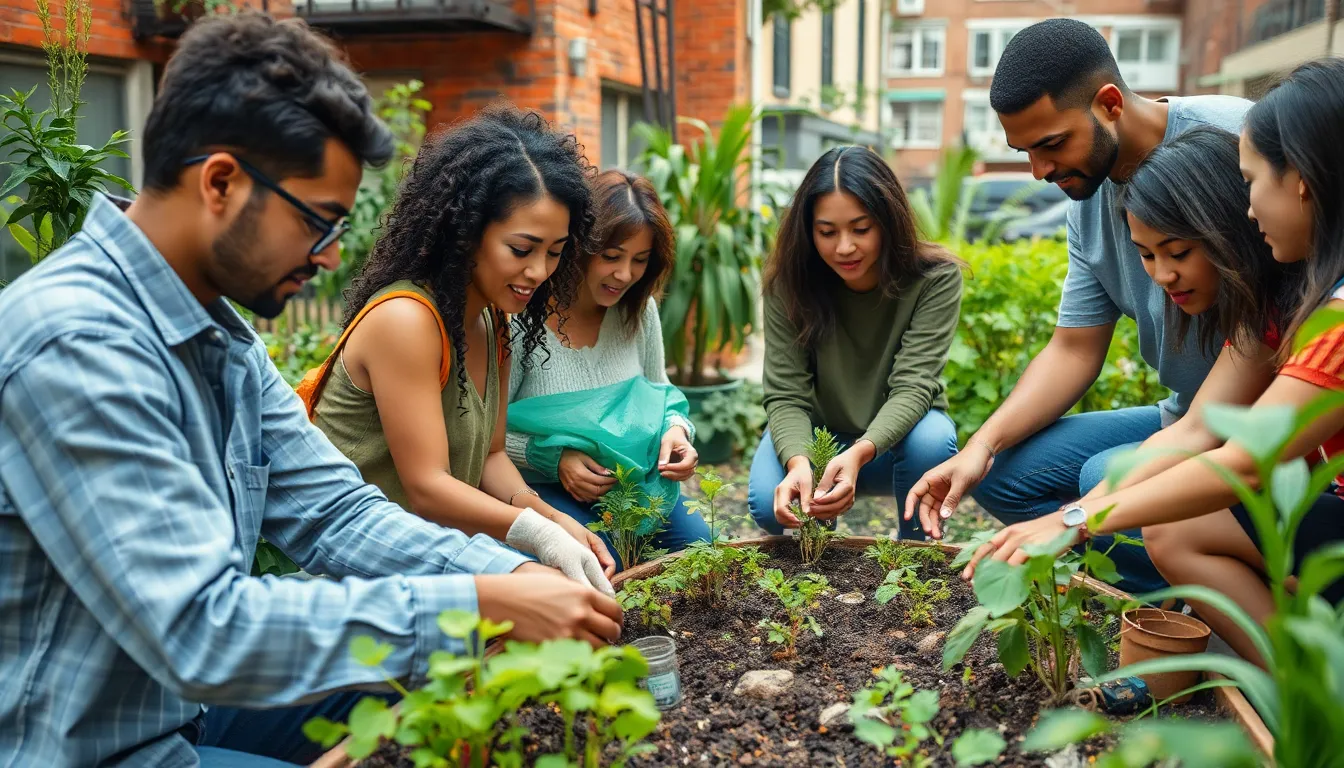In a world where convenience often trumps conscience, sustainable living emerges as the superhero we didn’t know we needed. Imagine a lifestyle that not only saves the planet but also makes you feel like a modern-day eco-warrior. It’s not just about hugging trees or wearing hemp sandals—though those are cool too. Sustainable living is all about making choices that help the Earth while keeping your carbon footprint as light as a feather.
Table of Contents
ToggleWhat Is Sustainable Living?
Sustainable living integrates practices that protect the environment and promote resource conservation. It encompasses choices in daily life that align with ecological balance, like reducing waste and using renewable energy sources. Individuals adopt this lifestyle to minimize their carbon footprint while fostering a healthier planet. This lifestyle promotes awareness of consumption patterns, encouraging mindful purchasing decisions.
Sustainable living encourages the use of energy-efficient appliances that conserve electricity and reduce utility bills. Biking or walking instead of driving presents alternative transportation methods that lower greenhouse gas emissions. In addition, growing food through home gardening supports local ecosystems and reduces dependence on industrial agriculture.
Communities play a crucial role in sustainable living by creating shared spaces for recycling and composting. Engaging in local initiatives fosters collaboration, amplifying the impact of individual efforts. Many sustainable practices, like sourcing food from farmers’ markets, support local economies and decrease transportation emissions.
Adopting a minimalist mindset can aid sustainable living by focusing on needs rather than wants. Choosing quality over quantity results in less waste and a more intentional lifestyle. Educating oneself about environmental issues strengthens the understanding of personal impact on the planet.
Efforts such as water conservation through rainwater harvesting methods maintain essential resources. Combining these strategies leads to a holistic approach to environmental stewardship. Overall, sustainable living demonstrates how individual actions collectively contribute to broader ecological health.
Key Principles of Sustainable Living

Sustainable living encompasses various principles that align daily actions with environmental stewardship.
Reduce, Reuse, Recycle
Reducing waste minimizes environmental impact. Emphasizing the importance of using items for longer periods significantly decreases landfill contributions. Reusing containers and repurposing materials allows individuals to find new functions for old items. Recycling eliminates waste by transforming materials back into usable resources, ensuring a circular economy. Communities and municipalities often provide recycling programs to streamline these efforts. Adopting these practices fosters a culture of sustainability and encourages more individuals to participate in protecting the planet.
Conservation of Resources
Conserving energy plays a pivotal role in sustainable living. Using energy-efficient appliances lowers consumption and reduces greenhouse gas emissions. Implementing water-saving techniques, such as fixing leaks and choosing drought-resistant plants, supports resource conservation. Individuals can also contribute by using public transportation or carpooling to lessen fossil fuel reliance. Supporting local farms cultivates a sustainable food system while preserving land. Making mindful choices about resource usage promotes a healthier environment and ensures availability for future generations.
Benefits of Sustainable Living
Sustainable living offers numerous benefits that enhance both the environment and individual well-being. This lifestyle creates opportunities for eco-friendly choices and fosters a stronger connection with the planet.
Environmental Impact
Sustainable living significantly reduces carbon footprints by promoting renewable energy sources. Individuals choosing solar or wind power contribute directly to pollution reduction. Additionally, minimizing waste plays a crucial role in conserving natural resources. Practices such as composting and recycling transform waste into valuable resources, enriching soil and reducing landfill use. Protecting biodiversity becomes easier through conscious choices like supporting local farms and eating seasonal foods. The cumulative effect of these actions bolsters ecological health and fosters resilience against climate change.
Economic Advantages
Economic benefits arise from sustainable living strategies. Investing in energy-efficient appliances often leads to lower utility bills over time. Individuals who embrace minimalism tend to prioritize quality over quantity, resulting in savings on unnecessary purchases. Supporting local businesses not only stimulates the local economy but also reduces transportation costs and emissions. Communities that focus on sustainability often create job opportunities in green industries. The transition to a circular economy promotes long-term financial stability, helping individuals and families thrive while prioritizing environmental health.
Challenges of Sustainable Living
Sustainable living presents several challenges that hinder its adoption. Awareness of these barriers is crucial for fostering enthusiasm toward eco-friendly practices.
Accessibility and Affordability
Many individuals face challenges due to the high costs associated with sustainable products. Eco-friendly items often come with a premium price tag. This cost can discourage families from making the switch to greener alternatives. Accessibility also plays a key role; not everyone lives near farmers’ markets or stores that prioritize sustainable goods. Geographic variations impact the availability of organic produce or renewable energy options. Overall, these factors create obstacles for those wanting to embrace a sustainable lifestyle.
Societal Norms and Habits
Deep-seated societal norms often resist sustainable practices. Common habits, such as single-use consumption, dominate lifestyle choices. Shifting from these established routines can prove difficult for many individuals. Social pressure may further encourage behaviors contrary to sustainability. Peer groups might prioritize convenience over environmental consciousness, reinforcing unsustainable choices. As a result, changing collective mindsets becomes a significant hurdle in promoting sustainable living.
How to Adopt Sustainable Living Practices
Adopting sustainable living practices can begin with simple adjustments in daily routines. These changes help reduce one’s environmental impact and promote a greener lifestyle.
Simple Changes for Everyday Life
Small, intentional changes can make a big difference. Using reusable bags for shopping cuts down on plastic waste significantly. Choosing energy-efficient LED light bulbs lowers electricity usage and costs over time. Drinking water from a reusable bottle not only conserves resources but also reduces single-use plastics. Composting food scraps transforms waste into nutrient-rich soil, supporting local gardening efforts. Transporting oneself through walking or biking minimizes carbon emissions and promotes health. Each of these practices supports sustainability and inspires further eco-friendly choices.
Community Involvement and Support
Engaging with the community fosters a culture of sustainability and collective impact. Local farmers’ markets provide access to fresh, sustainable food while supporting regional economies. Participating in community cleanup events keeps local environments clean, enhancing biodiversity. Sharing knowledge about eco-friendly practices with neighbors strengthens communal ties and encourages wider adoption. Joining sustainability-focused groups or initiatives amplifies individual efforts, creating lasting change. Together, these actions build a collaborative spirit that encourages collective commitment to sustainable living.
Sustainable living is more than a trend; it’s a commitment to making choices that benefit both the planet and personal well-being. By embracing practices that prioritize environmental health individuals can contribute to a more sustainable future.
Every small action counts from reducing waste to supporting local communities. As awareness grows the collective effort towards sustainability becomes stronger. The journey may have its challenges but the rewards are significant.
Adopting a sustainable lifestyle not only fosters a healthier environment but also enhances quality of life. Through conscious choices and community involvement everyone can play a role in creating a more sustainable world.



